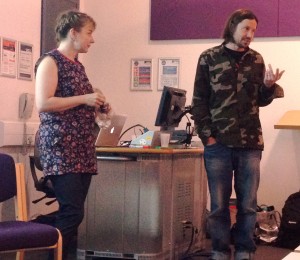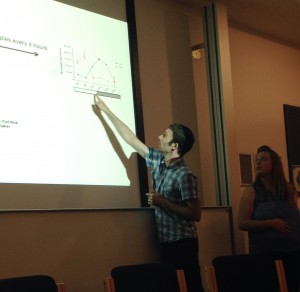On Sunday 22 June we hosted an event at Open City Docs Fest in London with four of the collaborators on Silent Signal.
 Artist Samantha Moore and Dr Serge Mostowy spoke about the process of developing Loop. Serge explained how having an artist in the lab had helped him to see the research differently, and how he had found this beneficial in thinking about how to communicate the work to non-scientists. He acknowledged that as a researcher it was crucial to convince the public of the need for his research to be funded, and saw that working with an artist to express the ideas behind his research could be beneficial in capturing people’s imagination.
Artist Samantha Moore and Dr Serge Mostowy spoke about the process of developing Loop. Serge explained how having an artist in the lab had helped him to see the research differently, and how he had found this beneficial in thinking about how to communicate the work to non-scientists. He acknowledged that as a researcher it was crucial to convince the public of the need for his research to be funded, and saw that working with an artist to express the ideas behind his research could be beneficial in capturing people’s imagination.
Samantha talked about the drawing task she gave to each scientist on her lab visit to see how each person visualised the process of septin (a new component of the host cell cytoskeleton) assembly into cage-like structures during bacterial infection, and how different each response was even though they were all researching different aspects of septin biology. What was particularly interesting was the way that several chose to represent septin proteins as jelly bean shapes, a symbolism that had come from a well-known visualisation presented in a review paper from another scientist.
 Artist Ellie Land and Dr Peter Oliver then spoke about their project, Sleepless. They had both found using online applications like Pintrest, Google Drive and Skype essential in developing the project given the distance between Ellie’s studio and Peter’s lab. These data sharing platforms allowed them to chance upon and explore the connecting themes with their own disciplines by investigating and responding to associated visuals posted by the other person. Ellie commented that it helped set a theme and a palette for the work which facilitated further discussions on the social impact of Peter’s work.
Artist Ellie Land and Dr Peter Oliver then spoke about their project, Sleepless. They had both found using online applications like Pintrest, Google Drive and Skype essential in developing the project given the distance between Ellie’s studio and Peter’s lab. These data sharing platforms allowed them to chance upon and explore the connecting themes with their own disciplines by investigating and responding to associated visuals posted by the other person. Ellie commented that it helped set a theme and a palette for the work which facilitated further discussions on the social impact of Peter’s work.
Quite early on they identified the representation and perception of time, repeating rhythms and synchronicity as overlapping themes. Both were excited to play with the representation of patterns and cycles in many forms; visually by altering the frame speed to and aurally with a collapsing and reforming drumming sound track to express the feelings of de-synchronisation and fractured sensations reported by patients.
In the Q&A the audience was interested in ideas discussed, such as how we might visualise the invisible, particularly with the septin cage assembly. Serge spoke about how recent advances in technology and that novel microscopy techniques have made it possible for the scientists to be able to see the infection process at a molecular, cellular and whole living organism level, in real time. This is an exciting development in the field, as it marks a switch from inferring patterns or collecting informative but representative visual data, to actually witnessing and capturing such events.
A question was posed about the challenges that the collaborators had faced coming from such different fields. Peter mentioned that it was key from the start to find a common language and that the speed dating process at the start of the project had been crucial in finding a way to articulate his work to the artists. He also commented that developing and discussing a work flow strategy helped them see feedback loops and stages to test and refine their ideas.
Serge felt pleased to have been matched with Samantha since the partnership was working well – he trusted her to use his research and hoped he could contribute to her work in a meaningful way. Serge explained how even the presence of Sam in the lab had sparked debate between the scientists that they might not have otherwise directly discussed and how her visits invigorated the staff both emotionally and academically.
Samantha added that during the speed dating event she had tried to test the scientists pitching their research by asking difficult questions to see how they reacted to a grilling, and was drawn to Serge’s openness about the fact that he did not have all the answers. Samantha also mentioned that she had found that having to digest so much complex data on such as specific topic had been tough.
Someone asked whether the outcome was to produce an artistic piece or was more to reveal scientific processes. Ellie said that the final work was aimed to engage everyone and to raise questions about the science through art that people could then debate. Samantha reaffirmed that the work would not be data visualisations of the science but that the artists would be transforming the research into an artwork that embodies the subjective perspective of the artist on the topic.

